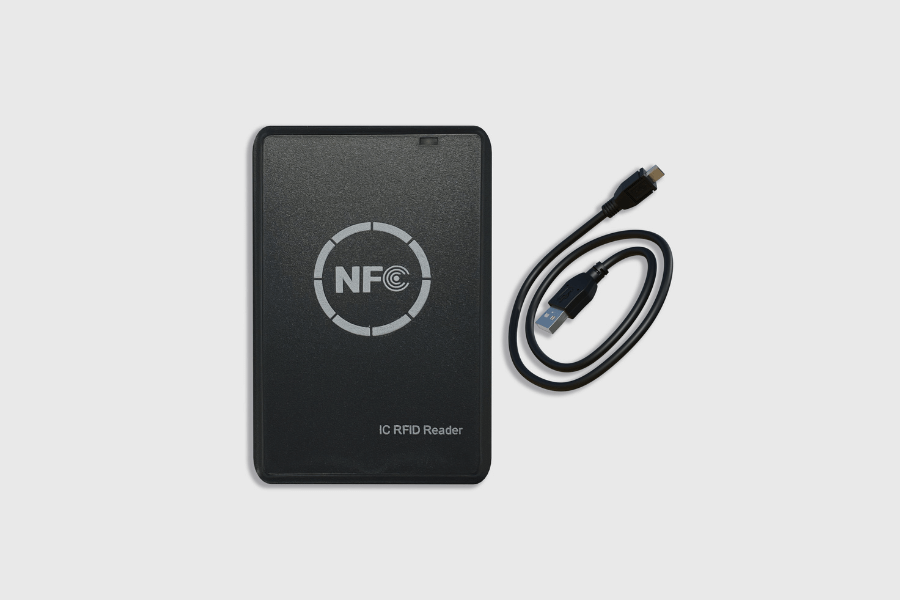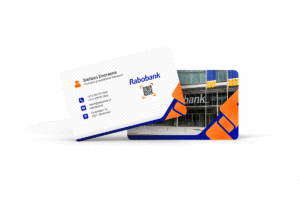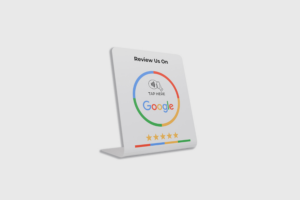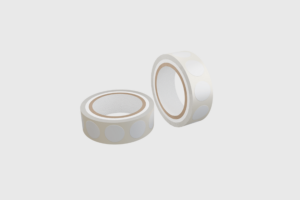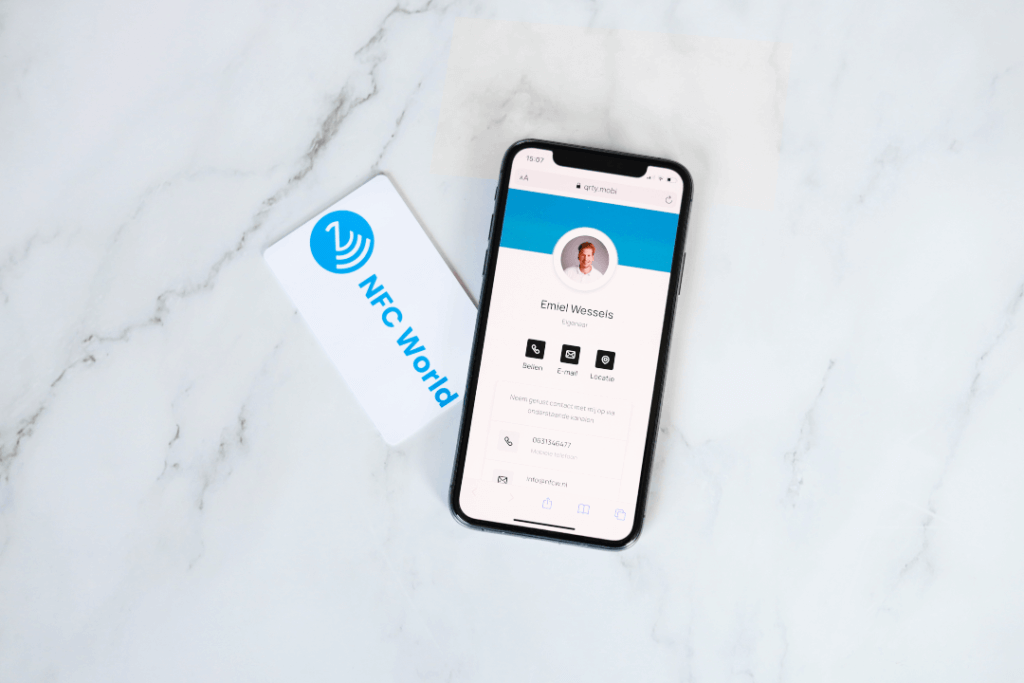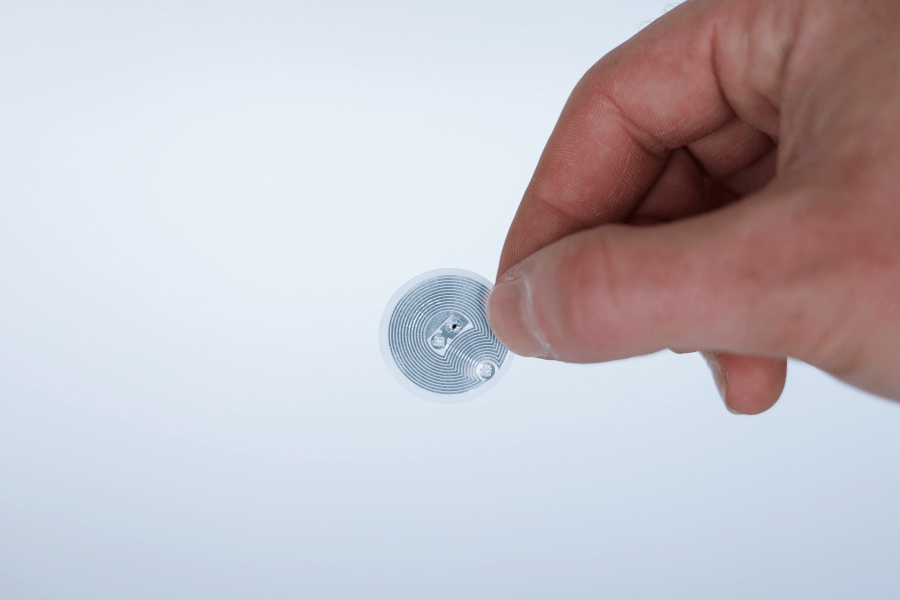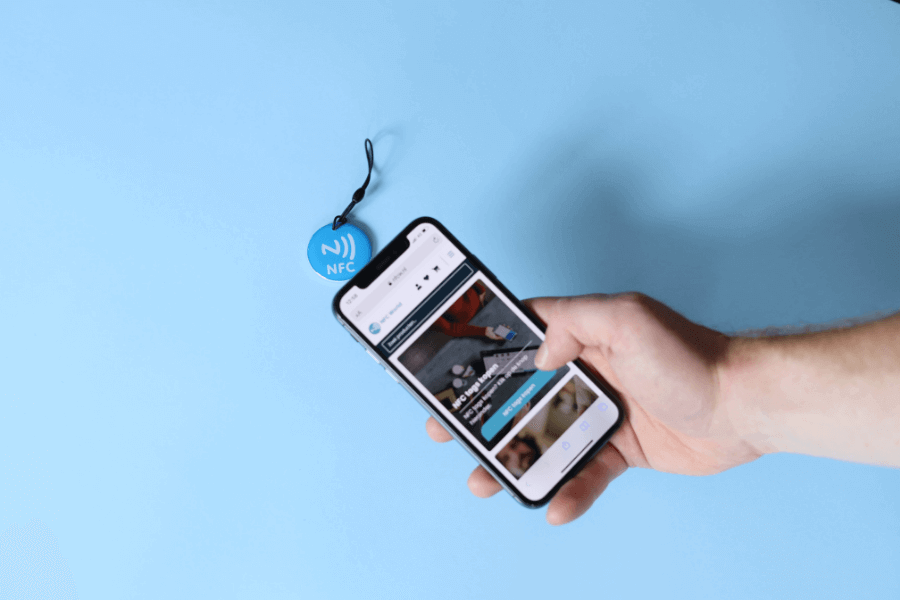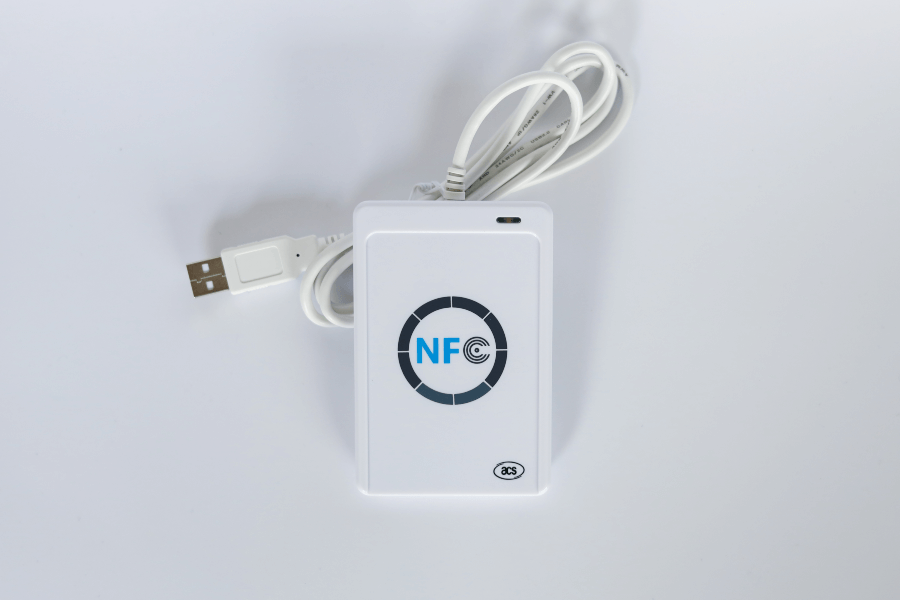No products in the cart.
NFC Products
Review products
Shopping Cart
What is an RFID reader and what can you do with it?

In this article, we are going to talk about RFID readers. After all, what can you do with them? And which RFID reader do you need? We are going to explain that to you. But before we go any further, you need to understand the basics of RFID.
RFID stands for ''Radio Frequency Identification,'' meaning that data can be transmitted via radio waves. NFC works the same way as RFID, but only for short distances, so the applications differ. With an RFID chip, you can send certain data to an RFID reader. In this way, it is possible to send data remotely so that the RFID reader can trigger something. For example, opening a barrier or clocking in on the shop floor.
Table of contents
What is the difference between RFID and NFC?
RFID and NFC are terms often used interchangeably. But there is a solid difference. RFID is in fact for longer distances than NFC. Whereas you can bridge about 3 centimeters with NFC, with RFID it is sometimes as much as 10 meters. For this reason, RFID is used for different applications than NFC. With NFC, we often see applications such as payment and connection to the digital world. RFID is mostly used for tracking, timekeeping and access gates.
There are several RFID chips on the market with different features and characteristics. These include differences in distance, security, technology and price. One example is the MIFARE Ultralight. This chip is mostly used as a disposable chip and is the cheapest RFID chip. If you go for a smarter chip with more quality such as the MIFARE Classic 1K, you will soon pay a lot more.
Before buying an RFID reader, you need to know carefully what kind of RFID chip you want to program. Not every RFID chip can be read with the same RFID reader. Like RFID chips, there are also different RFID readers. Each RFID reader operates at a certain frequency, just as RFID chips do. If the frequency of the reader is the same as the RFID chip then they can communicate with each other. Only then is it possible to read and program data on the chip. The frequency is expressed in megahertz (MHz). So it is important to check carefully if the RFID reader supports the number of MHz of your RFID chip you want to program.
There are a total of 3 types of frequencies, namely Low Frequency, High Frequency and Ultra High Frequency.
- Low Frequency chips feature 125KHz and have a short range from 2 to 100 centimeters away. These RFID chips are often used to provide short-range access, such as the gates at the gym.
- The High Frequency chips are 13.65MHz and have a range of 10 centimeters to 1 meter. At 2kb, this chip usually has double the number of bytes compared to Low Frequency chips. This makes the chip ideal for clock-in systems and timekeeping.
- The Ultra High Frequency RFID chips can have up to 950 MHz. You guessed it, this is perfect for long distances. With these RFID chips, you can sometimes go up to 12 meters in distance.
Would you like to program an Ultra High Frequency chip? Then you need this RFID Reader. The reader allows you to read, duplicate and program UHF (ultra high frequency) RFID chips. Do you want to program RFID chips with 125KHz as well as 13.65MHz? Then we recommend this RFID reader. This reader is compatible with both chips.
Why do you need an RFID reader to program RFID?
RFID chips cannot be programmed without an RFID reader. The antenna in the RFID chip allows it to communicate with another RFID chip. Since RFID can only communicate with other RFID devices, it is only possible to program the chip through an RFID reader.
What are the capabilities of an RFID reader?
With an RFID reader, there are actually two types of tasks you can perform, programming new data and duplicating an RFID chip. First of all, we are going to talk about duplication. Should you have an RFID access card and you would like to have more access cards, you can easily do this with an RFID reader. You can easily copy and paste the chip to a new pass. Of course, you can also add new data to the chip. You can program this data onto the chip yourself. There are several software options for this.
Some RFID readers can program NFC in addition to RFID, such as this NFC reader.
Buy RFID ReaderWhat is RFID and how does it work?
RFID stands for "Radio Frequency Identification" and uses radio waves to transmit data between an RFID chip and an RFID reader. This makes it possible to send data remotely and, for example, open a barrier or clock in on the shop floor. RFID is similar to NFC, but differs in that RFID is used for longer distances. Namely, NFC can only bridge up to 3 cm, while RFID can sometimes bridge up to 10 meters.
What are the differences between RFID and NFC?
RFID and NFC are often used interchangeably, but there is indeed a difference between the two. In fact, RFID is for longer distances than NFC. RFID can sometimes cover up to 10 meters, while NFC can only cover up to 3 cm. Because of this, both terms are used for different applications. NFC is mainly used for payments and connecting to the digital world, while RFID is used for tracking, timekeeping and access ports.
What types of RFID chips are there and how much do they cost?
There are several RFID chips on the market with different features and prices. For example, there are differences in distance, security, technology and price. An example of an RFID chip is the MIFARE Ultralight. This chip is commonly used as a disposable chip and is the cheapest RFID chip. If you go for a smarter chip with more quality, such as the MIFARE Classic 1K, you will soon pay a lot more.
What types of RFID readers are there and what should I look for when buying an RFID reader?
There are different types of RFID readers on the market that operate on a certain frequency, just like RFID chips. There are a total of 3 types of frequencies, namely Low Frequency, High Frequency and Ultra High Frequency. It is important to know which RFID chip you want to program, because not every RFID chip can be read with the same RFID reader. The frequency is expressed in megahertz (MHz). So it is important to check carefully whether the RFID reader supports the number of MHz of the RFID chip you want to program.
Don't miss anything and read all about NFC
Our most popular products
Reviews
★★★★★
Very satisfied with the serviceThe NFCW passes are a great example of how to use Sustainable Technology and still make an impact. We are very pleased with the service and quick response times.
Vera Timmermans - Evoke Staffing★★★★★
Quick response to inquiriesQuick response to questions. The dashboard is clear and easy to manage.
Shui Yi van de Laar - Endenburg Electrical Engineering★★★★★
Good price quality & Excellent serviceGood value for money & excellent service. Tickets were lost by mail but a solution was worked out together.
Bjorn Andelhofs - Topcon Positioning★★★★★
Very customer friendlyGood communication and fast service. Very customer friendly, and the site is easy and clear.
Astrid van Heinsbergen - HG International★★★★★
Very satisfied!We are very satisfied with our NFC business cards from NFC World. The dashboard is user-friendly and the cards are easy to use.
Natacha Wuestman - Wuestman★★★★★
The cards work easily and very wellThe cards work easily and very well. This way we are more sustainable, because we do not have to order 100's of paper business cards for our colleagues.
Eva Hartman - Lycens BVGive 20%, Get 20% 🎁
Give your friends 20% off their next order. And we'll give you 20% off for every successful referral.
Invite friendsAll our products are subject to our terms and conditions. All prices include VAT and other taxes and exclude any shipping and service charges. You can read how we handle cookies in our privacy policy.
